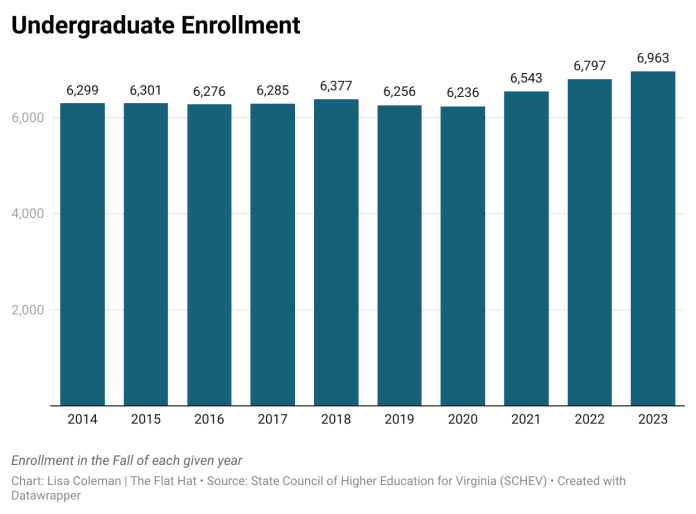This academic year, the College of William and Mary continues a trend of acceptance rates getting lower. Approximately 5,800 students were offered admission to the College, out of nearly 18,000 applications: representing an acceptance rate of 33%. Since 2020, the College has reported a 25% increase in total applications.
According to Axios, the College accepted 39.3% of its 7,156 in-state applicants versus 46.9% during the COVID-19 pandemic in 2020.
Other institutions such as Virginia Tech and the University of Virginia received increased applications as well. James Madison University recorded over a 104% increase in applications just last year.
Due to this increase in applications, the acceptance rates for many of Virginia’s state universities have significantly decreased.
Moreover, Stateline reported that colleges and universities across the country admit more out-of-state students, partly because of higher tuition rates.
The College’s board of visitors increased tuition rates for all students last year. At a full board meeting in April, the board voted 15-1 to raise the College’s in-state tuition by 2.5% and out-of-state tuition by 3.3% for fiscal years 2025 and 2026.
For the 2023-2024 application year, the College admitted 28% of out-of-state applicants, with a general acceptance rate of 33%.
Just under 270,000 first-time applicants applied to Virginia’s 15 public four-year institutions, over 100,000 more applications than the schools received a decade ago.
The College received significantly fewer applicants than other schools in the Commonwealth, but still reported an increase.
Since 2020, the undergraduate enrollment at the College has increased consistently: 6,236 in 2020; 6,543 in 2021; 6,797 in 2022; and 6,963 in 2023.
Graduate enrollment has been increasing as well, with the population growing from 1,509 in 2014 to 2,270 in 2023.
Max Strackbein ’27 commented on the increase in undergraduate enrollment.
“I think in reality it would be fine for it to go up to 8000 undergraduates, but only if we had the infrastructure to allow that because we don’t,” Strackbein told The Flat Hat. “Currently, juniors and seniors are not guaranteed housing, but also don’t have spaces to park when coming from their off-campus apartments. So, we can’t accommodate more people without changing our parking and dorms.”
The College’s Housing and Dining Comprehensive Facilities Plan does not anticipate more beds added at the end of its ten-year period.
Moreover, the College has also been granting generally more STEM-H degrees, or Science, Technology, Engineering, Math and Health Sciences, with 778 degrees awarded in 2023. The College awarded 498 STEM-H degrees in 2013.
Associate Provost for Enrollment and Dean of Admission Tim Wolfe ’95, M.Ed. ’01 commented on the trend.
“In Fall 2019, W&M announced a plan for managed enrollment growth that aimed for approximately 150 additional undergraduates annually, for an increase of 600 students after four years,” Wolfe wrote in a statement provided to The Flat Hat by College Assistant Director of Media Relations Nathan Warters. “While the start of the pandemic in 2020 resulted in a delay to initial implementation, we began moving forward accordingly in 2021. We have since reached that four-year goal and now continue aiming for a consistent entering fall first-year class of between 1600-1650 students. While there may be year-to-year fluctuations, we’ve landed within that range each of the past three years, and the Admission Office will be aiming to do that again this cycle.”
Wolfe also gave his thoughts on why the College has become more selective in recent years.
“While post-pandemic trends have seen prospective students applying to more colleges nationally, the combination of a 25% increase in applications since the pandemic along with significant growth in Early Decision applications the past two years, still resulted in the university becoming more selective during this time,” he added.
According to SCHEV, enrollment among White and Asian or Pacific Islander, Non-Hispanic students has also been increasing at the College, while other demographics have remained mostly constant.
More detailed statistics regarding admissions at the College are expected in November. UVA released its data first among Virginia universities, reporting the decrease of Black first-year students by about 1% while its Latino population saw an approximately 2% increase.
The enrollment data from UVA comes after the Supreme Court struck down race-conscious admissions programs last year in Students for Fair Admissions v. Harvard.
NOTE (09/15/24): Article contains comments from Associate Provost for Enrollment and Dean of Admission Tim Wolfe ’95, M.Ed. ’01. Wolfe did not respond in time for the publication of this article on print and so his quotes were not included in that version.

